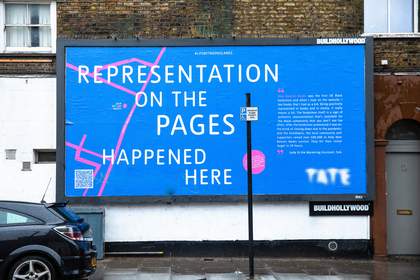
Image: Courtesy Jack Arts (@Jack_Arts)
Running until 6 March
Free to visit
Starting this week, Tate is taking over billboards and buildings across London, shining a light on the stories and celebrating places connected to London’s Caribbean cultural heritage. Devised as a community-led extension of Tate Britain's Life Between Islands: Caribbean British Art 1950s – Now exhibition, the campaign will run until 6 March. This free, pop-up campaign features a host of personal, poignant, and never-before-heard testimonies from 20 leading artists, creatives, community leaders and members of Tate’s BAME staff network including Turner Prize and Academy Award winner Sir Steve McQueen CBE and fashion designer Grace Wales Bonner.
Over 40 markets, cinemas, clubs, restaurants, libraries, and community centres across the city are highlighted. Visitors are invited to hear the stories of those who have loved and used them, and how they have shaped London’s Caribbean communities, spanning the Stuart Hall Library in Pimlico to Dalston’s Ridley Road Market and Notting Hill’s Leamington Road Villas. Neil Kenlock, recently awarded an MBE, underscores the importance of the Black Cultural Archives and Brixton Market, whilst Wyn Baptiste, Director and Producer, and the son of one of Notting Hill Carnival early organisers, shares why ‘Trini Hill’, a corner of the Brunel Estate near Westbourne Park is his favourite festival spot. Photographer Ingrid Pollard reflects on summers spent working at Crystal Palace Farm whilst photographer Dennis Morris shares the moment he first met the iconic reggae artist Bob Marley.
Inspired by English Heritage’s Blue Plaque scheme, each location is visible through a billboard, pasted-up poster, or floor vinyl sticker – featuring exclusive anecdotes from each contributor. It has been made possible thanks to media space kindly provided by Jack Arts, the project's media partner. The campaign will be live for two weeks, with a map outlining the locations and stories available to download on Tate’s website here.
Highlights include:
Sir Steve McQueen CBE on why Saturday School trips to the Macbeth Centre in Hammersmith helped foster a sense of pride and community, whilst growing up in a hostile political environment, as a young child.
“As a black child growing up in the UK you are politicised from the start. You find yourself asking the questions who, why, how and what? This spot marked the place I attended Saturday school at five years old. For me, it was a space in which I felt a sense of pride and community within what was otherwise a hostile environment. It was, in many ways, the making of me and many others I am sure of it.”
Playwright Michael McMillan on seven places that shaped his childhood, adolescence and career including weekly Ridley Road market visits with his mum, Keskidee Arts Centre in Islington and Black Ink Collective.
“Keskidee Arts Centre was the first Black community arts centre in the UK, off Caledonian Road in Islington. It was run by the Guyanese-born Oscar Abrams, with the African-American Rufus Collin as Artistic Director. It was where Linton Kwesi Johnson developed dub poetry while running the library, Angela Davis spoke, and Bob Marley filmed the video for ‘Is This Love?’. I went there often as a teenager, seeing Black theatre productions like Edgar White’s ‘Lament for Rastafari’, Derek Walcott’s ‘Pantomine’ and Lennox Brown’s ‘Throne in an Autumn Room’. I would eventually become part of this world as a playwright
Artist Denzil Forrester’s expressive depictions of dance halls and clubs captured London’s 1980s dub scene in large oil paintings, exploring its African cultural roots. He reflects on seeing Jah Shaka play at Phebes – also the title of his 1983 painting – every Friday night, and the significance of Colvestone Youth Centre in inspiring his lifelong love of painting.
Photographer Dennis Morris moved to the UK from Jamaica as a child, growing up in east London. He shares how a club at St. Marks Church sparked his interest in photography, as well as the moment he first met Bob Marley outside The Speakeasy Club. After asking to take a photograph, Dennis was invited on Marley and the Wailers’ 1973 tour.
"During my last year at secondary school, I had read that Bob Marley was due to tour England for the first time. He was the new voice of Reggae. He had a rebellious stance, lyrically and musically; I was smitten. I decided to go to the Club where he was due to play his first gig of the tour. The Club was called the Speakeasy Club on Margaret Street, W1. I arrived in the early afternoon, and after waiting outside for a few hours, he and the band arrived for their sound check. As he approached, I asked him, could I take his picture. “Yeah, mon!” he replied, “Com’ in”. For whatever reason, Bob took to me and after the soundcheck, he invited me to come on the tour. The rest is history."
Fashion designer Grace Wales Bonner’s carefully researched collections encompass critical theory, musical composition, literature, and history, embracing a multiplicity of perspectives, via a hybrid of European and African-Atlantic approaches. For this trail, Wales Bonner unpacks why the Stuart Hall Library in Pimlico – home to the Inviva archive – has been so foundational to her work.
Senior Art Handling Technician at Tate, Mikei Hall delves into his childhood visits to the People’s Sound Record Store in West London, and why you can’t imagine Caribbean culture without its music, whilst Marketing Assistant Laila St. Vie shares why Burgess Park holds a special place in her family’s heart.
